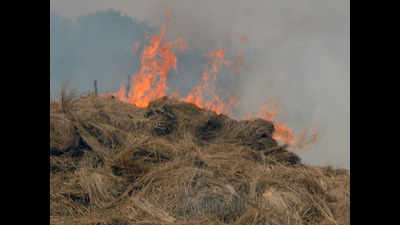- News
- City News
- patna News
- Stubble burning adds to air pollution woes in Bihar
Trending
This story is from December 15, 2020
Stubble burning adds to air pollution woes in Bihar
Deterioration in air quality in several parts of the state has become a common phenomenon during the winters. Several factors, including stubble burning, are responsible for rise in pollutants in the air.

Picture used for representational purpose only
PATNA: Deterioration in air quality in several parts of the state has become a common phenomenon during the winters. Several factors, including stubble burning, are responsible for rise in pollutants in the air.
The burning of crop residue, which is common in states like Punjab and Haryana, has also started picking up in Bihar with the advent in mechanised harvesting of crops.
Around 900 farmers in Bihar have been penalised for stubble burning since September, including 462 in Rohtas, 133 in Kaimur, 100 in Nalanda, 93 in Buxar, 40 in Gaya, 33 in Patna, 21 in Bhojpur and seven in Jamui. These farmers have been excluded from government’s incentives and schemes for the next three years.
Environmentalists have expressed concern over burning of crop residue and opined that the mechanised farming appears to be the key reason behind the problem.
Ghosh said plans are afoot to use remote-sensing technology to curb stubble burning in the state. “This technology should be used to collect data so that immediate action could be taken against errant farmers by the local authorities. We are in talks with the officials of the United Nations Development Programme (UNDP) to prepare a proposal for the same,” Ghosh added.
He added, “Farmers in Bihar have switched from manual harvesting of crops to machineries being imported from Punjab and Haryana. In mechanised harvesting, the machine leaves taller residue of crops. In manual harvesting, residue of crops remains close to the ground. In a bid to cut costs, farmers burn the residues for next harvesting,” he said.
A farmer from Bhojpur said he hired machines to cut crops in order to save money as manual work costs more. “It not only saves money, but also time. As far as crop residues are concerned, I have no other option but to burn them,” he said.
“It costs just one rupee to get a match box. However, hiring workers to clear crop residues would cost at least Rs 10,000,” a Vaishali farmer said.
The burning of crop residue, which is common in states like Punjab and Haryana, has also started picking up in Bihar with the advent in mechanised harvesting of crops.
Around 900 farmers in Bihar have been penalised for stubble burning since September, including 462 in Rohtas, 133 in Kaimur, 100 in Nalanda, 93 in Buxar, 40 in Gaya, 33 in Patna, 21 in Bhojpur and seven in Jamui. These farmers have been excluded from government’s incentives and schemes for the next three years.
Environmentalists have expressed concern over burning of crop residue and opined that the mechanised farming appears to be the key reason behind the problem.
Ashok Ghosh, chairman of Bihar State Pollution Control Board, said stubble burning in the state has been reported from several districts and it would increase in the near future. “To stop this practice, real-time monitoring and stern action are needed. By the time the state government reacted, the residues of crops were already burned,” he said.
Ghosh said plans are afoot to use remote-sensing technology to curb stubble burning in the state. “This technology should be used to collect data so that immediate action could be taken against errant farmers by the local authorities. We are in talks with the officials of the United Nations Development Programme (UNDP) to prepare a proposal for the same,” Ghosh added.
He added, “Farmers in Bihar have switched from manual harvesting of crops to machineries being imported from Punjab and Haryana. In mechanised harvesting, the machine leaves taller residue of crops. In manual harvesting, residue of crops remains close to the ground. In a bid to cut costs, farmers burn the residues for next harvesting,” he said.
A farmer from Bhojpur said he hired machines to cut crops in order to save money as manual work costs more. “It not only saves money, but also time. As far as crop residues are concerned, I have no other option but to burn them,” he said.
“It costs just one rupee to get a match box. However, hiring workers to clear crop residues would cost at least Rs 10,000,” a Vaishali farmer said.
End of Article
FOLLOW US ON SOCIAL MEDIA











